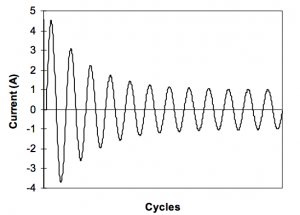The nature of the load that will be connected to the AC power source is very important in determining the correct type of supply. Generally loads can be classified as linear or non-linear. Linear loads consist exclusively of reactive, inductive or resistive components and can thus be modeled as an LCR network.
Since the elements of the load impedance are linear, the current drain on the AC power source is uniform and the resulting current waveform will follow the voltage waveform with a certain amount of phase shift. The magnitude and direction (lagging or leading) of the phase shift between the current and voltage waveforms is dependent on the reactance of the load. Common examples of linear loads are incandescent light bulbs and electric motors. Linear loads are often confused with resistive loads, but resistive loads are only a subset of all linear loads.
How linear loads affect power source selection
Linear loads are conceptually simple, but they do have an impact on AC power source requirements, especially with respect to in-rush current. For a purely resistive load, the in-rush current is the same as the steady state current. For reactive loads, however, the in-rush current can be considerably higher. The value depends on the phase angle of the voltage when power is applied to the load.
If the load cannot be modeled to determine the maximum in-rush current, then it should be measured with a current transformer and storage oscilloscope or suitable power analyzer. To find the worst case in-rush current for capacitive loads, you apply the source voltage at the 90 or 270 degree point. In addition to the maximum value, you also need to measure the length of time that the inrush current exceeds the rms or steady state value. For capacitors and transformers, this is usually less than one cycle. For motors, however, it can be many cycles, until the motor is up to speed, as shown in the figure below.

The AC source is often required to supply a much higher current during the start-up period. If this start-up period lasts for several cycles, it is necessary to select an AC source with rms capability equal to the in-rush current required.
Many precision AC power sources avoid this need by including a programmable current limit time-out that can be set to accommodate loads that require longer startup periods. Effectively the source operates in a constant current mode at reduced output voltage during this time. This can be used when the lower input voltage during this inrush period does not cause any issues with the load. One example would be a low line cut-off that may cause the load to shut down. For instance, some motor starters can have such a function. Practical examples of these types of loads are washers, dryers, refrigerators etc. and many industrial motor applications.
Non-linear loads complicate the AC power source selection process, and we'll discuss them in a future blog post. For more information on how to choose an AC power source, download Application Note 105, “Understand AC Source Specifications and Technology.”
